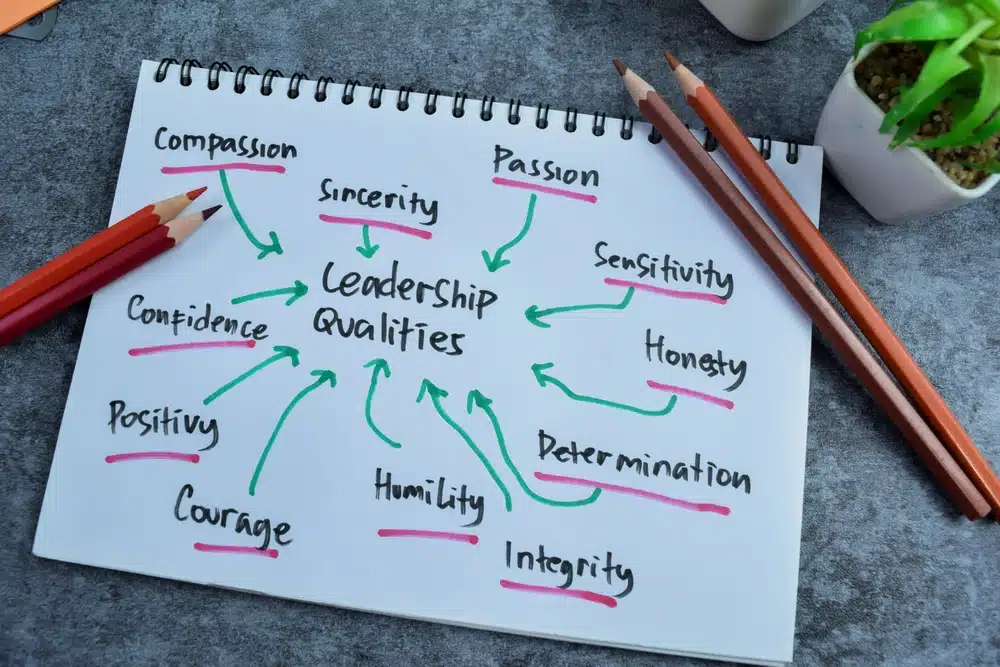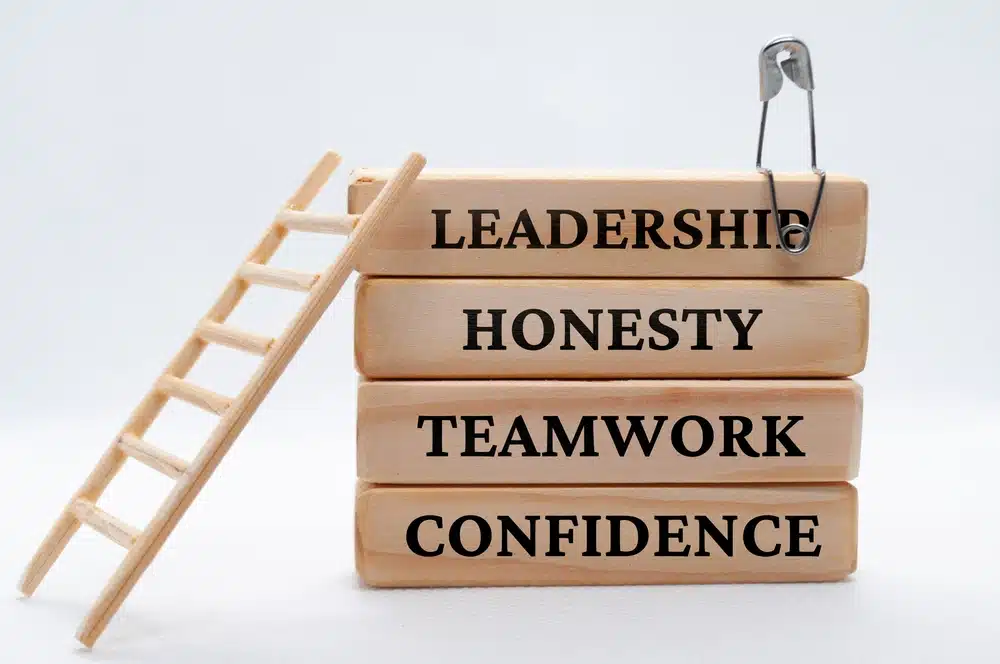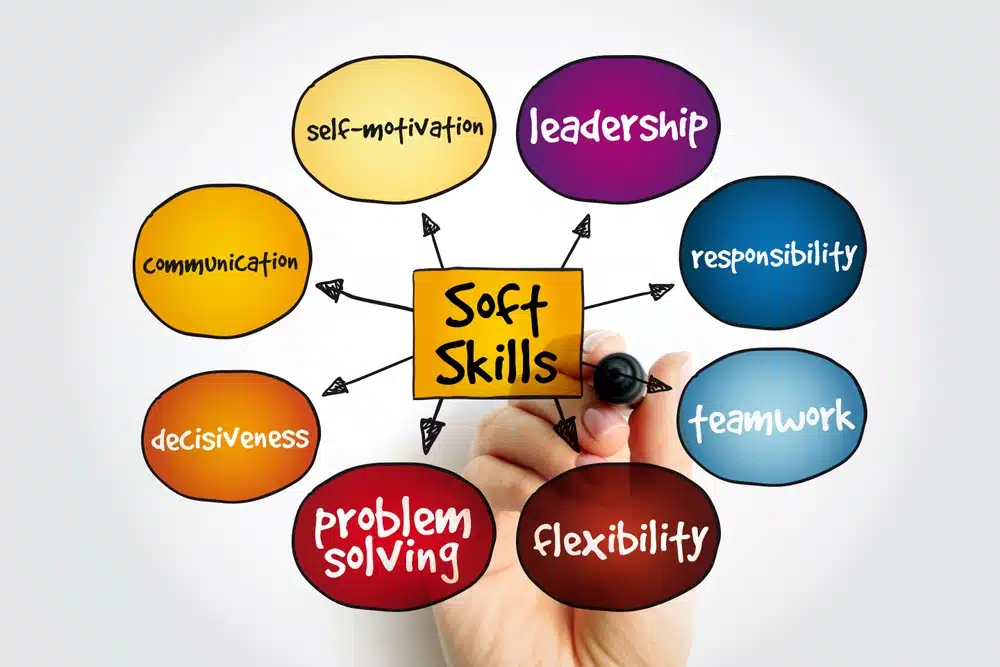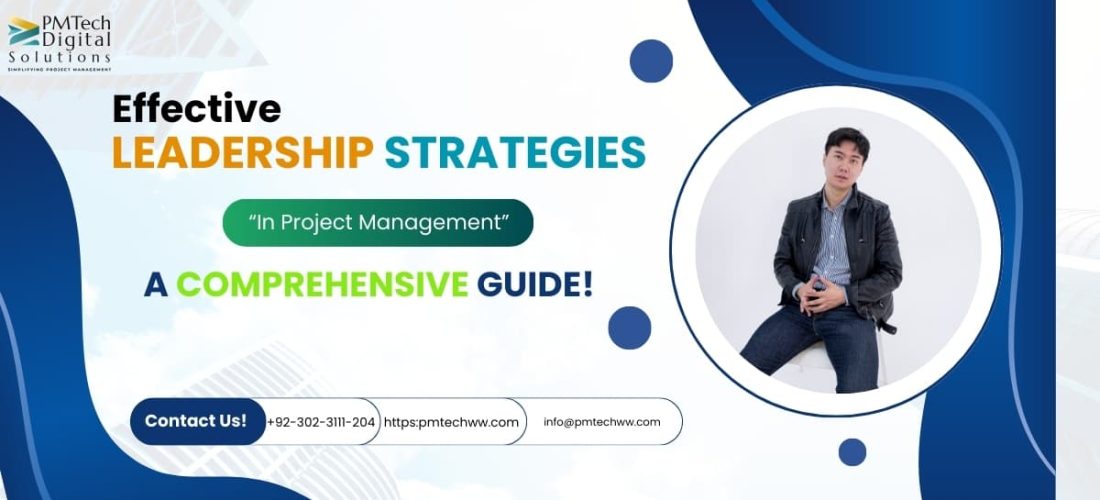When it comes to success and achieving organizational goals, leadership in project management is the one that drives successful outcomes. Project managers now inspire, motivate, and guide teams towards a shared vision. Effective communication, team motivation, and strategic planning are crucial skills for navigating complex projects.
Strong leadership is vital in today’s rapidly changing business landscape. A recent survey reveals 84% of companies predict a shortage of strong leaders. This isn’t due to lack of aspiration, but societal shifts causing uncertainty about effective leadership.
Project managers must adapt, learn, and develop skills to lead teams to success. This responsibility is critical for overcoming challenges and achieving project objectives.
Key Takeaways
- Leadership in project management involves guiding, motivating, and empowering teams to achieve shared goals.
- Effective communication is crucial for project leaders to ensure clarity, alignment, and collaboration among team members.
- Team motivation is a critical aspect of leadership, requiring project managers to inspire and engage their teams throughout the project lifecycle.
- Strategic planning enables project leaders to align projects with organizational objectives and navigate challenges effectively.
- Developing strong leadership skills is an ongoing process that requires continuous learning, self-reflection, and adaptability.
The Importance of Leadership in Project Management
Effective leadership is crucial for project success in today’s business world. Complex projects require strong leadership to overcome challenges and inspire teams. 80% of organizations use project management to monitor and evaluate projects, highlighting its importance.

Communication is vital, with 95% of successful project managers citing it as key. Negotiation skills are essential, with 85% using them to align stakeholders. Risk management expertise is crucial for safeguarding project outcomes.
Leadership goes beyond technical skills. 85% of projects risk failure if managers lack interpersonal skills. Generating enthusiasm and fostering trust directly impact team morale and efficiency. Honesty enhances trust among stakeholders and facilitates transparent decision-making.
| Leadership Skill | Importance |
|---|---|
| Emotional Intelligence | Enables project managers to remain calm and positive during difficult times, motivate team members, address conflicts, and make decisions in the best interests of the project. |
| Cultural Intelligence | Equips project managers with the skills to effectively manage multicultural teams, fostering understanding and collaboration. |
| Effective Communication | Allows project leaders to build trust among team members, ensuring successful project execution through clear and transparent communication. |
| Motivation and Inspiration | Encourages teams to be engaged, creative, and produce innovative solutions, leading to project success. |
| Positive Work Environment | Strong leaders create positive work environments that foster creativity, innovation, and collaboration, essential for successful projects. |
Project managers’ decisions directly impact project outcomes. Leaders must make ethical choices considering both project interests and people’s well-being. Continuous learning and professional development help project managers improve leadership skills and drive exceptional results.
Types of Leadership
Project managers must adapt their leadership styles to guide teams effectively. With over 110,897 leadership titles on Amazon.com, numerous approaches exist. Goleman emphasized leadership styles’ impact on team climate and outcomes. Tannenbaum & Schmidt highlighted the importance of being insightful and adaptable.
Six key leadership styles in project management include:
- Coercive leadership: Directing team members with clear instructions and expectations.
- Authoritative leadership: Providing a vision and direction for the team to follow.
- Affiliative leadership: Focusing on building strong relationships and emotional connections within the team.
- Democratic leadership: Encouraging team participation in decision-making and valuing input from all members.
- Pacesetting leadership: Setting high standards and leading by example to drive performance.
- Coaching leadership: Developing team members’ skills and helping them reach their full potential.
Effective project managers apply these styles based on the situation. Kotter noted the value of creating urgency in crisis situations, aligning with pacesetting leadership.

Five broader categories of leadership relevant to project managers include:
| Leadership Style | Key Characteristics |
|---|---|
| Laissez-Faire | Hands-off approach, allowing team members to work independently with minimal guidance. |
| Transactional | Focuses on goals and rewards, using a system of incentives to motivate team members. |
| Servant | Prioritizes the needs and interests of the team, supporting and empowering team members. |
| Transformational | Inspires and motivates team members through a shared vision, encouraging innovation and growth. |
| Charismatic | Relies on the leader’s personality traits, such as energy and self-confidence, to persuade and influence the team. |
Project managers must consider factors influencing leadership style choice. These include personal characteristics, team members’ traits, organizational culture, and project environment. Evaluating these factors helps create comprehensive project management plans for team success.
“The most effective leaders are those who can adapt their style to the needs of their followers and the demands of the situation.” – Ken Blanchard
Transformational leadership is crucial in today’s evolving business landscape. Embracing this style and leveraging AI, automation, and advanced software enables data-driven decisions. It also helps assess risks and improve team communication.
As remote work increases, outcome-focused leadership becomes essential. Utilizing effective digital communication tools keeps teams aligned and engaged. Adapting to these changes ensures project managers remain effective in guiding their teams.
Key Qualities of Successful Project Leaders
Project leaders guide teams towards successful outcomes. They need technical expertise, business acumen, and interpersonal skills. The Project Management Institute identifies key qualities of successful project managers. These traits help them manage complexities, resources, and stakeholder relationships effectively.

Emotional Intelligence
Emotional intelligence is crucial for project leaders. It helps them understand and manage their own and team members’ emotions. This trait increases team satisfaction by 75% and improves project outcomes by 40%.
Leaders with high emotional intelligence excel at building trust. They resolve conflicts effectively and foster a positive team culture. These skills are essential for project success.
Adaptability and Flexibility
Today’s business environment demands adaptable and flexible project leaders. They must navigate unexpected challenges and changes. Successful managers adjust plans while maintaining focus on project objectives.
This flexibility allows for quick, informed decisions. It keeps projects on track, even in adverse situations. Adaptable leaders are better equipped to handle uncertainties.
“Adaptability is about the powerful difference between adapting to cope and adapting to win.” – Max McKeown
Visionary Thinking
Visionary thinking is essential for successful project leaders. It involves anticipating trends, identifying opportunities, and setting long-term goals. This approach aligns projects with organizational strategies and drives innovation.
Projects led with a clear vision see a 23% increase in ROI. This is compared to projects without strategic thinking. Visionary leaders create more value for their organizations.
To cultivate visionary thinking, project leaders should:
- Stay informed about industry trends and best practices
- Encourage creative problem-solving within their teams
- Regularly communicate the project’s vision and goals to stakeholders
- Seek feedback and insights from diverse perspectives
| Quality | Impact on Project Success |
|---|---|
| Emotional Intelligence | 75% increase in team satisfaction, 40% improvement in project outcomes |
| Adaptability and Flexibility | Enables quick decision-making and maintains project focus |
| Visionary Thinking | 23% increase in ROI compared to projects without clear strategic thinking |
Developing emotional intelligence, adaptability, and visionary thinking creates a strong foundation for success. These qualities empower leaders to guide their teams effectively. They navigate challenges with ease and deliver exceptional results.
Setting the Vision & Direction for Your Project Team
Project managers must establish a clear project vision and set the team’s direction. By aligning project objectives with organizational goals, we inspire our team to work towards a common purpose. A well-defined vision guides the team and helps everyone grasp the bigger picture.

The PMI’s Pulse of the Profession® survey reveals that 32% of project management professionals value both technical expertise and leadership skills. Visionary project managers think ahead and plan for future challenges. By defining clear goals, we can convey a compelling vision of project success to our team.
“Leadership is the capacity to translate vision into reality.” – Warren Bennis
To effectively set the project vision and direction, follow these steps:
- Understand the organization’s strategic objectives and how the project aligns with them.
- Clearly define the project’s goals, deliverables, and success criteria.
- Communicate the project vision to the team, stakeholders, and sponsors.
- Ensure that everyone understands their roles and responsibilities in achieving the project objectives.
- Regularly review and reinforce the project vision to keep the team motivated and focused.
A clear project vision creates a shared sense of purpose and boosts team motivation. It increases the chances of project success. A well-articulated vision not only guides the project but also unites the team towards achieving remarkable results.
Building & Nurturing a High-Performing Team
Building a high-performing team is crucial for project success. It involves selecting the right individuals and fostering collaboration. By nurturing our teams, we can unlock their potential and achieve remarkable results.

Selecting the Right Team Members
Ideal teams consist of no more than 8 people to avoid coordination challenges. We seek individuals from different departments with specialized knowledge and expertise. Dr. Raymond Meredith Belbin identified nine roles necessary for effective team functioning.
These roles include Coordinator, Team Worker, and Monitor/Evaluator. A balanced mix of these roles creates a well-rounded team capable of tackling any challenge.
Fostering Collaboration & Trust
Effective communication is crucial for high-performing teams. It leads to improvements in motivation, productivity, and profitability. We encourage open communication and set clear objectives to align everyone’s efforts.
Creating an environment where team members feel comfortable sharing ideas is essential. This approach helps resolve conflicts quickly and prevents them from escalating.
Creating a Positive Team Culture
We strive to create a culture that promotes engagement, loyalty, and high performance. Understanding team dynamics, roles, strengths, and limitations is crucial for improving performance. We invest in trust-building activities and foster continuous learning.
Mastering emotional intelligence significantly impacts teamwork. It improves communication effectiveness and promotes a sense of belonging within the team.
| Key Elements of High-Performing Teams | How We Incorporate Them |
|---|---|
| Effective Communication | Encouraging open and transparent communication, setting clear objectives |
| Collaboration and Trust | Fostering a feedback culture, investing in trust-building activities |
| Positive Team Culture | Understanding team dynamics, promoting engagement and loyalty |
| Balanced Team Roles | Selecting team members based on necessary roles and expertise |
Our focus on these key elements has led to successful management of multimillion-dollar projects. We’ve used Waterfall, SDLC, and Agile methodologies. Our commitment to high-performing teams drives exceptional results consistently.
Effective Communication Strategies for Project Leaders
Effective communication is vital for successful project leadership. Strategic communication ensures team members, stakeholders, and clients are aligned. It fosters a collaborative and productive work environment. Implementing these strategies can lead to better project outcomes.

Transparency builds trust and credibility within project teams. Open dialogue addresses potential issues early. Regular updates on progress, changes, and challenges keep everyone informed. This approach minimizes misunderstandings and aligns team efforts towards common goals.
Ensuring Clear & Open Communication
Utilize various communication channels for clarity. These include verbal and written interactions, active listening, and body language. Convey project objectives, expectations, and feedback concisely. This approach minimizes confusion and clarifies roles and responsibilities.
“The single biggest problem in communication is the illusion that it has taken place.” – George Bernard Shaw
Project leaders act as intermediaries between stakeholders and team members. They ensure smooth communication flow. Emotional intelligence helps adapt communication styles to individual needs. This fosters an inclusive team culture that encourages open dialogue and collaboration.
Providing Regular Updates & Feedback
Regular updates and feedback keep teams motivated and on track. Dedicate time for one-on-one meetings, team huddles, and progress reports. This ensures awareness of project status, upcoming milestones, and potential roadblocks.
Constructive feedback promotes growth and development. Provide timely, specific, and actionable feedback. This helps team members improve, celebrate successes, and refine their skills. Effective feedback is crucial for continuous improvement.
Leverage communication technology to streamline information sharing. Use project management software, collaboration tools, and virtual meeting platforms. These tools ensure efficient communication across the entire project team.
Invest in communication skills through certification programs like PMP. Pursue ongoing professional development opportunities. Prioritize open, transparent, and respectful communication. This approach builds strong, high-performing teams ready for modern project management challenges.
Leadership in Project Management: Navigating Challenges & Change
Effective leadership is vital for project managers to overcome challenges and changes. It empowers us to make sound decisions, manage change, and guide teams towards success. Strong leadership skills are essential for achieving project goals.
Managing conflicting stakeholder priorities is a significant challenge. To address this, we must define project scope and align expectations early. Engaging stakeholders and maintaining open communication ensures everyone works towards a common goal.
Resistance to change is another hurdle project managers face. Our role is to communicate change benefits and involve team members in the process. We must provide support to help them adapt and foster a culture of resilience.
Effective decision-making is crucial in project management leadership. We must evaluate options, consider potential impacts, and make informed choices. Accountability is key; we take responsibility for decisions and hold teams accountable for performance.
“Leadership is the capacity to translate vision into reality.” – Warren Bennis
Successful leaders focus on effective time and resource management. This involves:
- Proper planning
- Tracking progress
- Judicious resource utilization
- Leveraging technology when appropriate
Consider these statistics highlighting the importance of effective leadership in project management:
| Statistic | Implication |
|---|---|
| 65% of projects fail to meet all of their stated goals successfully without a project management process, dropping to around 20% when proper project management is implemented. | Implementing a robust project management process, led by effective leadership, significantly increases the chances of project success. |
| There is a 40% difference in project success rates between organizations where leadership makes decisions in less than 1 hour instead of those that take up to 5. | Swift decision-making by project leaders contributes to higher project success rates, emphasizing the importance of decisive leadership. |
| 57% of projects fail due to a communication breakdown. | Effective communication, facilitated by strong leadership, is essential to prevent project failure and ensure success. |
Embracing challenges and changes in project management helps develop leadership skills. Clear communication, effective decision-making, and accountability are key to navigating complexities. These skills drive teams towards success and deliver exceptional results in project management.

Top 6 Leadership Theories
Effective leadership is crucial for project success. Leadership theories offer insights into successful leaders’ traits and behaviors. These theories help us understand how to guide and motivate teams towards achieving project goals.
Various leadership theories have emerged over time. Each provides a unique perspective on great leadership. Let’s explore the top 6 leadership theories relevant to project management:
- Trait Theory: Also known as the “Great Man” theory, it suggests certain individuals possess innate leadership qualities. These may include charisma, confidence, decisiveness, and strong communication skills.
- Behavioral Theory: This focuses on leaders’ actions rather than inherent traits. It proposes that leadership can be learned through observation and training. Behavioral theories often categorize leaders into different styles, such as task-oriented or people-oriented.
- Contingency Theory: These theories emphasize that effective leadership depends on specific situations and factors. Adapting one’s leadership style to circumstances is key. Factors include task nature, team composition, and project timeline.
- Situational Theory: This theory highlights the importance of flexibility in leadership. Leaders should adjust their approach based on team members’ competence and commitment. Project demands also influence leadership style.
- Transactional Theory: Transactional leadership uses rewards and consequences to motivate team members. Leaders set clear expectations and provide feedback. They offer incentives for meeting objectives. This theory emphasizes structure, accountability, and performance management.
- Transformational Theory: This approach aims to inspire and empower team members. Transformational leaders are visionary and charismatic. They focus on personal and professional growth. These leaders create a shared sense of purpose.
Great leaders are not born, they are made. And they are made just like anything else, through hard work. And that’s the price we’ll have to pay to achieve that goal, or any goal.
Applying these theories can enhance project managers’ abilities to inspire teams. It helps them navigate challenges and deliver successful projects. No single theory is universally applicable. Effective leaders adapt their approach to team needs and project context.
| Leadership Theory | Key Focus | Implications for Project Management |
|---|---|---|
| Trait Theory | Innate qualities of leaders | Identifying and leveraging natural leadership abilities within the team |
| Behavioral Theory | Actions and behaviors of leaders | Developing and training project managers in effective leadership behaviors |
| Contingency Theory | Adapting leadership style to the situation | Assessing project factors and adjusting leadership approach accordingly |
| Situational Theory | Flexibility based on team and project needs | Tailoring leadership style to team members’ competence and commitment levels |
| Transactional Theory | Rewards and consequences for motivation | Setting clear expectations, providing feedback, and managing performance |
| Transformational Theory | Inspiring and empowering team members | Creating a shared vision, fostering innovation, and supporting personal growth |
Project managers should embrace multiple leadership theories. Adapting approaches based on project and team needs leads to greater success. Continuous learning and skill refinement help us guide teams effectively. This ultimately results in achieving project goals and delivering exceptional outcomes.
Delegation & Empowerment: Leveraging Your Team’s Strengths
Effective delegation and empowerment drive project success. By leveraging team strengths and assigning tasks based on skills, we optimize outcomes. This approach fosters trust and collaboration within the team.
Identifying team strengths is crucial for effective delegation. Matching strengths with project needs sets the stage for successful task completion. This approach develops team skills and optimizes resource utilization.
Assigning Tasks Based on Skills & Strengths
To effectively delegate tasks, we must consider the following factors:
- Identifying individual team members’ strengths and areas of expertise
- Matching tasks with the right team members based on their skills and interests
- Ensuring clear communication and setting expectations for delegated tasks
- Providing necessary support and resources for successful task completion
Careful task assignment enhances productivity and project efficiency. It also contributes to the professional growth of team members. This approach benefits both the project and individual team members.
Empowering Team Members to Make Decisions
Empowering team members to make decisions is critical for effective delegation. This fosters ownership and accountability, leading to higher job satisfaction. It also increases commitment to the project’s goals.
“Empowerment is the key to unlocking the full potential of our team members and nurturing future leaders.”
To successfully empower our team, we must:
- Establish clear boundaries and guidelines for decision-making
- Provide the necessary information and resources for informed decision-making
- Encourage open communication and feedback loops
- Support and trust our team members in their decisions
The impact of effective delegation on project management efficiency is significant. Consider these statistics:
| Statistic | Impact |
|---|---|
| Delegating project leadership improves project outcomes and quality | Higher project success rates and customer satisfaction |
| Effective delegation leads to optimal utilization of resources and talents | Improved project speed and efficiency |
| Delegation boosts team morale and engagement | Increased job satisfaction and commitment from team members |
| Leveraging digital tools like monday.com and Make streamlines delegation processes | Automated tasks and efficient progress tracking |
Incorporating effective delegation strategies enhances project efficiency and fosters a positive team culture. This approach drives overall project success and creates a more engaged workforce. The benefits extend beyond individual projects to the entire organization.

Conflict Resolution Techniques for Project Managers
Conflicts are inevitable in team environments. Project managers must handle them effectively to maintain a positive team dynamic. Managers spend about 42% of their time reaching agreements during conflicts. Conflict resolution requires problem-solving, goal-setting, compromise, and settling personality differences.
Understanding the Drama Triangle is crucial for preventing destructive conflicts. It consists of three roles: Persecutor, Victim, and Rescuer. Identifying these roles helps manage conflicts proactively. Adopting a proactive management approach is vital for a healthy work environment.
Constructive conflict can benefit organizations. It aids in personal growth and organizational improvement. It occurs when people grow from the conflict and team cohesiveness forms. Involvement of affected individuals increases, leading to problem-solving.
“Conflict is inevitable in any organization. The key is to learn how to manage it constructively.” – Kenneth Cloke and Joan Goldsmith
Unmanaged conflict can harm organizations. It threatens unity, partnerships, and relationships. Early identification prevents escalation and maintains team morale. Regular meetings help recognize conflicts proactively. Monitoring project metrics can serve as early conflict indicators.
Clear communication channels foster open and honest team interactions. Active listening, like maintaining eye contact, is crucial for resolving conflicts. Collaborative problem-solving increases the chances of finding innovative solutions. Brainstorming sessions and conflict resolution workshops can be beneficial.
Establishing clear project goals prevents conflicts from misunderstandings. Communicate goals through a project charter and regular updates. Mediation and negotiation are useful when conflicts persist. A skilled, impartial mediator is vital for successful resolution.
- Identify the root cause of the conflict
- Facilitate open and honest communication
- Encourage active listening and empathy
- Engage in collaborative problem-solving
- Establish clear goals and expectations
- Utilize mediation and negotiation when necessary
| Conflict Resolution Technique | Description |
|---|---|
| Collaboration | Working together to find a mutually beneficial solution |
| Compromise | Finding a middle ground where both parties make concessions |
| Accommodation | One party gives in to the other’s demands to resolve the conflict |
| Competition | One party assertively pursues their own interests at the expense of the other |
| Avoidance | Withdrawing from the conflict or postponing its resolution |
Using these conflict resolution techniques promotes a positive team dynamic. Proactive management helps navigate project management challenges effectively. This approach fosters a productive and harmonious work environment.
Motivating & Engaging Your Project Team
Project leaders must create an environment that fosters motivation and engagement among team members. Understanding individual drivers and tailoring approaches can unlock full potential and achieve remarkable results. Let’s explore effective strategies for keeping project teams motivated and engaged.
Setting a clear vision and communicating it effectively is crucial for maintaining team motivation. Project managers who fail to convey compelling visions often struggle with lackluster team motivation. Articulating project goals and connecting them to organizational objectives creates a sense of purpose that drives engagement.
Effective project leadership combines passion, focus, and integrity to inspire and motivate team members. These qualities help leaders build trust and create a positive work environment.
Recognizing & Celebrating Achievements
Recognizing and celebrating team achievements powerfully boosts motivation and engagement. A simple “thank you” can make team members feel valued and appreciated. Implementing a recognition program can highlight outstanding contributions and milestones reached.
| Recognition Type | Impact on Motivation |
|---|---|
| Verbal praise | Immediate boost in morale and motivation |
| Written acknowledgement | Lasting sense of appreciation and value |
| Public recognition | Increased pride and sense of accomplishment |
| Rewards and incentives | Tangible motivation for continued high performance |
“Employee recognition is a low-cost, high-impact activity that can significantly boost motivation, engagement, and loyalty.”
Providing Opportunities for Professional Development
Investing in team members’ professional development shows commitment to their growth and success. Offering skill enhancement, training, and career advancement opportunities demonstrates that we value their contributions. This investment fosters long-term development and loyalty.
- Providing access to relevant training programs and workshops
- Encouraging participation in industry conferences and events
- Offering mentorship and coaching opportunities
- Creating a culture of continuous learning and knowledge sharing
Prioritizing professional growth increases engagement, motivation, and commitment to project success. Fostering an environment that values learning, and development builds a high-performing team. This approach consistently delivers exceptional results and drives overall project success.
Aligning Projects with Organizational Goals and Strategies
Project managers must align projects with organizational goals and strategies. This alignment contributes to long-term success and growth. Organizations that do this see a 15% increase in project success rates.
Misalignment leads to failure. In fact, 87% of projects fail to meet objectives due to lack of alignment. Strategic alignment is crucial for project relevance and success.
Aligned projects boost employee engagement by 48% and return on investment by 30%. Companies aligning projects are 25% more likely to deliver on time and within budget.
“Aligning projects with organizational goals is not just a best practice; it’s a necessity for driving business success and achieving long-term growth.”
To effectively align projects with organizational goals, consider the following steps:
- Understand the company’s mission, vision, and strategic objectives
- Identify how your project contributes to achieving these goals
- Communicate the project’s strategic relevance to stakeholders and team members
- Regularly review and adjust the project to maintain alignment with organizational strategies
Effective communication and strong project governance increase alignment success rates by 40%. Additionally, 82% of organizations report improved team collaboration and integration through goal alignment.
| Benefit of Aligning Projects with Organizational Goals | Percentage |
|---|---|
| Increase in project success rates | 15% |
| Increase in employee engagement | 48% |
| Higher return on investment | 30% |
| Increased likelihood of delivering projects on time and within budget | 25% |
Strategic alignment reduces risks and enhances risk management processes for 63% of companies. A staggering 94% of organizations agree it’s crucial for long-term growth and success.

Project managers must ensure projects contribute to overall organizational success. Prioritizing strategic alignment drives meaningful results. This focus positions companies for long-term growth and prosperity.
Developing Your Leadership Skills as a Project Manager
Project managers must continuously invest in their leadership development to stay effective. Seeking feedback, finding mentors, and engaging in learning can enhance skills and guide teams to success.
Gallup research shows people using strengths daily are six times more likely to be engaged at work. Yet only 34% of managers can confidently name their direct reports’ strengths. Understanding team members’ strengths and inspirations is crucial for effective leadership.
“Get-to-know-you” activities during team meetings can provide valuable insights into team members. This understanding can ultimately improve project performance and team dynamics.
Seeking Feedback & Mentorship
Developing leadership skills effectively involves seeking feedback from team members, peers, and superiors. Encourage open communication and create a safe environment for sharing thoughts and suggestions. Active listening helps identify areas for improvement and adjust leadership style accordingly.
Mentorship is a valuable resource for leadership growth. Find an experienced project manager or industry leader to guide you. A mentor can offer new perspectives, help develop skills and provide advice on navigating challenges.
Continuous Learning & Professional Development
Staying current in your field requires continuous learning and professional development. Attend industry conferences, workshops, and training sessions to learn about trends and best practices. This investment demonstrates commitment to personal and professional growth.
Online resources like YouTube videos and structured courses offer step-by-step guidance on leadership topics. These tools provide valuable insights and practical strategies for daily work implementation.
Leadership is a skill that improves with practice and dedication. Actively seek feedback, find mentors, and engage in continuous learning. Embrace growth and development to become a more effective project manager.
Leadership Vs. Management: What’s the Difference?
Project managers often use “leadership” and “management” interchangeably. However, these terms have distinct differences. Understanding leadership vs management is vital for guiding teams to success.
Leadership
Leadership inspires and motivates others to achieve common goals. It sets a clear vision, communicates effectively, and aligns individual goals with organizational objectives. Leaders empower team members, foster creativity, and encourage risk-taking.
They lead by example, demonstrating behaviors and values they expect from their team. These include integrity, commitment, and professionalism.
“Leadership is the art of getting someone else to do something you want done because he wants to do it.” – Dwight D. Eisenhower
Management
Management focuses on processes, planning, and task execution. Managers organize resources, delegate responsibilities, and ensure efficient work completion. They use their authority to assign tasks, monitor progress, and make decisions.
While essential for stability and short-term goals, management may not inspire the same passion as leadership. It maintains order and structure within organizations.
| Leadership | Management |
|---|---|
| Focuses on people | Focuses on processes |
| Sets vision and direction | Plans and organizes tasks |
| Inspires and motivates | Delegates and controls |
| Encourages risk-taking | Minimizes risks |
Why Leadership & Management Skills are both Important?
Both leadership and management skills are crucial for project success. Effective project managers balance overseeing execution and inspiring teams towards goal achievement. They must set clear objectives, communicate with stakeholders, and foster collaboration.
Additionally, they need to make data-driven decisions, adapt to changes, and learn from both successes and failures. These skills help create a balanced approach to project management.
- Set clear objectives and expectations
- Communicate effectively with stakeholders
- Foster collaboration and trust within the team
- Make data-driven decisions
- Adapt to changes and challenges
- Celebrate successes and learn from failures
How to Lead by Example?
Leading by example powerfully inspires and influences your team. As a project manager, you can demonstrate leadership through accountability, integrity, and commitment. Take responsibility for your actions and admit mistakes.
Be honest and ethical in all dealings. Show full investment in the project’s success. Provide opportunities for team members to learn and develop new skills.
- Being accountable: Take responsibility for your actions and decisions and admit when you make mistakes.
- Showing integrity: Be honest, transparent, and ethical in your dealings with team members and stakeholders.
- Demonstrating commitment: Put in the extra effort when needed and show that you are fully invested in the project’s success.
- Encouraging growth: Provide opportunities for your team members to learn, develop their skills, and take on new challenges.
Combining leadership and management skills creates a positive team culture. It helps navigate challenges and drives projects towards successful outcomes. This balanced approach ensures both inspiration and effective execution.
Top 3 Inspiring Leadership Quotes
Great leaders have shared powerful quotes that inspire and motivate us. These quotes remind us of essential qualities for effective leadership. Let’s explore three timeless leadership quotes that continue to resonate.
“A leader is one who knows the way, goes the way, and shows the way.” – John C. Maxwell
John C. Maxwell, a leadership expert, stresses the importance of leading by example. Effective leaders possess knowledge and vision to chart the course. They also demonstrate courage and determination by walking the path themselves.
By actively engaging in the journey, leaders inspire their teams. This approach motivates others to follow suit and achieve great things together.
“Leadership is the capacity to translate vision into reality.” – Warren Bennis
Warren Bennis, a pioneer in leadership studies, highlights leadership’s transformative power. True leaders can articulate a compelling vision and rally others around it. They possess strategic thinking skills and execution capabilities to turn ideas into results.

By bridging vision and reality, leaders drive progress and innovation. This ability to manifest change is a hallmark of exceptional leadership.
“The greatest leader is not necessarily the one who does the greatest things. He is the one that gets the people to do the greatest things.” – Ronald Reagan
Ronald Reagan reminds us that leadership isn’t just about personal accomplishments. Effective leaders empower and inspire others to achieve their full potential. They create an environment where individuals feel valued and motivated.
Great leaders equip their teams to tackle challenges and pursue excellence. By unlocking collective potential, they multiply their impact and leave a lasting legacy.
| Quote | Author | Leadership Principle |
|---|---|---|
| “A leader is one who knows the way, goes the way, and shows the way.” | John C. Maxwell | Leading by Example |
| “Leadership is the capacity to translate vision into reality.” | Warren Bennis | Visionary Thinking |
| “The greatest leader is not necessarily the one who does the greatest things. He is the one that gets the people to do the greatest things.” | Ronald Reagan | Empowering Others |
These quotes remind us of core leadership principles. Leading by example, turning vision into reality, and empowering others define exceptional leadership. Let these words guide us through challenges and opportunities.
May they inspire us to become more effective leaders. By embracing these principles, we can ignite the leader within and make a lasting impact.
Conclusion
Effective leadership is crucial for successful project management. Diverse strategies like ethical, transformational, servant, and cross-cultural leadership significantly impact team performance and collaboration. These approaches foster trust, inspire creativity, and leverage strengths of globalized teams.
Project managers must possess decision-making, communication, team-building, and negotiation skills to lead effectively. Flexibility, time management, and continuous development drive innovation and success within organizations. Building a positive workplace culture improves employee retention and project outcomes.
Mastering leadership strategies is essential for navigating project management complexities. Setting clear vision and nurturing high-performing teams align projects with organizational goals. Effective leaders inspire their teams and drive performance in today’s dynamic business environment.
Project managers who embrace these leadership principles can steer their projects towards successful completion. By focusing on these key aspects, they can deliver outstanding results and foster a culture of excellence.
Frequently Asked Questions
What is the importance of leadership in project management?
Leadership is vital for guiding teams through complex projects and driving performance. It helps overcome challenges and maintain focus on project goals. Effective leaders inspire commitment and ensure project success.
What are some common leadership styles in project management?
Autocratic leaders take control and make decisions alone. Democratic leaders encourage team participation in decision-making. Transformational leaders inspire and motivate team members.Transactional leadership is based on rewards and punishments. Servant leaders prioritize the needs of their team members.
What are the key qualities of successful project leaders?
Successful project leaders possess emotional intelligence, adaptability, and visionary thinking. They understand and manage emotions effectively. These leaders can adjust plans when needed and anticipate future trends.
How can project managers build and nurture high-performing teams?
Project managers can build high-performing teams by selecting the right members and fostering collaboration. Creating a positive team culture is crucial. This involves encouraging open communication and resolving conflicts constructively.
What are effective communication strategies for project leaders?
Effective strategies include ensuring clear communication among team members, stakeholders, and clients. Project managers should provide regular updates on progress. They need to share information about changes and be transparent about challenges.
How can project managers motivate and engage their teams?
Project managers can motivate teams by recognizing achievements and providing constructive feedback. Creating opportunities for professional development is important. Understanding what drives each team member helps tailor motivation approaches.
What is the difference between leadership and management in project management?
Management focuses on processes, planning, and execution. Leadership is about people, vision, and change. Effective project managers must balance both roles. They oversee project execution while inspiring the team to achieve success.
How can project managers develop their leadership skills?
Project managers can develop leadership skills by seeking feedback and finding mentors. Engaging in continuous learning and professional development is crucial. Leadership can be learned and improved over time.
What is the importance of risk management in project leadership?
Effective leaders must skillfully identify, assess, and mitigate potential project risks. Proactive risk management minimizes disruptions and keeps projects on track. It enables informed decision-making when challenges arise.
How can project leaders effectively manage stakeholders?
Successful leaders engage stakeholders throughout the project, understanding their expectations and addressing concerns. Building strong relationships based on trust is crucial. This secures support and alignment with project goals.



















16 Responses
I don’t think the title of your article matches the content lol. Just kidding, mainly because I had some doubts after reading the article.
I like this weblog very much, Its a rattling nice situation to read and find information.
Your article helped me a lot, is there any more related content? Thanks!
Absolutely indited content, thanks for entropy. “He who establishes his argument by noise and command shows that his reason is weak.” by Michel de Montaigne.
Almost all of what you say is supprisingly precise and that makes me ponder the reason why I had not looked at this in this light before. This article really did turn the light on for me as far as this specific subject matter goes. Nonetheless at this time there is actually one particular factor I am not too comfortable with and while I try to reconcile that with the main theme of your issue, permit me see what all the rest of the subscribers have to point out.Well done.
Transport is an important link of the e-commerce chain, but it comes
with many challenges for small to medium-sized companies.
From excessive shipping costs and supply delays to stock points and
worldwide delivery hurdles, there are numerous obstacles for
businesses to overcome. However, by implementing strategic options
and investing in key upgrades similar to transport automation, companies can save on transport bills and improve customer satisfaction on the similar time.
Handling returns is an unavoidable a half of e-commerce, but it may be costly and time-consuming.
His strength camp advanced right into a globally renowned fitness center in 2015, quickly increasing in various elements of the Usa and Europe.
Elliott also began a project that focused on the
motivation of unemployed people and gave them the liberty to pursue their passion and earn money from it.
So, how precisely do you construct strong muscle and pack
on weight? Read extra about this superb muscle weight acquire program.
HGH is not legal to use for performance or
bodybuilding functions or any use exterior prescribed medical
settings. All off-label prescribing of HGH is
unlawful in the Usa and most different nations.
The value alone will often rule out HGH for many guys who would
love to try it. Cheap generic kits (often called UGL) can price as little as
$100. Anything about $200 is considered costly for generic HGH kits.
As I mentioned, Riptropin is a highly regarded rebranded generic, and a 100iu equipment (10 x 10iu vials) may
be discovered for $400. Typically, real pharma-grade
HGH kits can cost anywhere from $600 to $800,
generally up to $1000 or extra.
Not only this, but he also motivated and inspired
a lot of people to be the most effective of themselves.
He got famous for more reasons than simply his strongman coaching videos.
He usually answered fan queries and incessantly put collectively motivational films.
If you’re someone who’s into strongman coaching, you most likely know who Elliott Hulse is.
Nevertheless, if you’re new to this, you might not know who Elliott Hulse actually
is.
The Important Ripped ProgramThe Important Ripped Program was designed
to remodel your physique right into a ripped chiseled and idolized physique.
Every Little Thing from weight coaching, cardio, supplements and food
plan are all mapped out for you. There comes a point in time for all of us when we wish to
showcase what we’ve completed within the gym.
When you take your shirt off ensure your muscular tissues are revealed they usually aren’t
lined by layers of fats.
While this lent launch adds a special dimension to your journey
as a founding member of the Power Revolution, Black Fast
Bodybuilding just isn’t restricted to a specific timeframe.
You can begin this system everytime you’re ready to embark on a transformative journey.
The principles are timeless, and your dedication to becoming
a task mannequin can start at any second.
Whether you choose to optimize your physique or not, your body
is being biohacked, albeit in a lower than optimum way.
For instance, in the Usa, we are being biohacked by things like fluoride
in the water. The Rational Fasting Biohackings Guide is your
key to take again management over your body
and to optimize it to the level of an elite athlete.
To a sure point, HGH is highly helpful for many of us. Whereas a
slower-release type of HGH was developed practically 20 years in the past, its manufacturing
was deemed too expensive to proceed, and to date, it has
not been checked out once more. Such a product would have made it possible to inject HGH as quickly as each few weeks quite than every day as we do now.
HGH has a number of medical uses, and extra potential uses are
being researched all the time, starting from the treatment of debilitating situations
right through to more therapeutic and anti-aging purposes.
You’ll continually get new issues to try out, which may even assist to better gasoline your workouts.
Some of this is primarily based on moral and environmental reasons, but his concentrate on bioenergy
and physique chemical substances has led him to avoid issues
that are commonly used in mass meals manufacturing.
This breakdown may also decrease the amount of fat saved
by most individuals.
When a excessive dosage of HGH is all of a sudden taken, joint ache can be more severe.
This facet effect can be minimized by starting at a decrease dosage to permit your
body to adjust. HGH customers usually report
headaches and different symptoms similar to flu. These are often very short-term and sometimes subside inside a short
time of starting HGH use. Some users can recuperate adequately
from Anavar without PCT. If PCT is required, a standard Nolvadex 4-week cycle is sufficient.
Thousands of experiences, comments, and evaluations are written yearly by guys utilizing HGH.
Try this for rapid dimension, energy, and muscle-building outcomes.
Moreover, in distinction to many “typical” bodybuilding channels—Elliott Hulse emphasizes the importance of spirituality.
Contemplating that the mind and body ought
to work in harmony for the last word physique.
The cycle described in the video isn’t beginner friendly
since it included multiple compounds, one of which was trenbolone – a harsh anabolic
steroid to build muscle fast (Renaldo).
On Saturday, Elliott Hulse goes for a light run or a low-impact hike and makes sure to stretch and carry out some
lively meditation exercises.
They offer a massive selection of essential vitamins that can greatly enhance the completeness of one’s nutrition plan.
Consuming creatine increases the production of ATP (Adenosine
Triphosphate). This additional results in enhancing one’s
overall athletic performance. Elliott could be very disciplined in phrases
of his eating habits, and there are specific meals he avoids in any respect costs.
I got what you intend, thanks for posting.Woh I am glad to find this website through google. “Don’t be afraid of opposition. Remember, a kite rises against not with the wind.” by Hamilton Mabie.
I used to be recommended this blog by way of my cousin. I’m not positive whether or not this submit is written through him as nobody else understand such certain approximately my difficulty. You’re incredible! Thanks!
I don’t think the title of your article matches the content lol. Just kidding, mainly because I had some doubts after reading the article.
70918248
References:
steroids vs testosterone boosters (deesreview.com)
Thanks for sharing excellent informations. Your site is very cool. I am impressed by the details that you have on this site. It reveals how nicely you perceive this subject. Bookmarked this website page, will come back for extra articles. You, my pal, ROCK! I found just the information I already searched everywhere and simply could not come across. What a great web site.
70918248
References:
none (Layne)
fabuloso este conteúdo. Gostei bastante. Aproveitem e vejam este conteúdo. informações, novidades e muito mais. Não deixem de acessar para saber mais. Obrigado a todos e até mais. 🙂
Este site é realmente fascinate. Sempre que acesso eu encontro novidades Você também vai querer acessar o nosso site e descobrir mais detalhes! conteúdo único. Venha saber mais agora! 🙂
Hello There. I found your blog using msn. This is an extremely well written article. I will be sure to bookmark it and come back to read more of your useful info. Thanks for the post. I’ll definitely return.
I loved as much as you’ll receive carried out
right here. The sketch is tasteful, your authored material stylish.
nonetheless, you command get got an impatience over that you wish be delivering the following.
unwell unquestionably come more formerly again as exactly the same nearly a lot often inside
case you shield this increase.